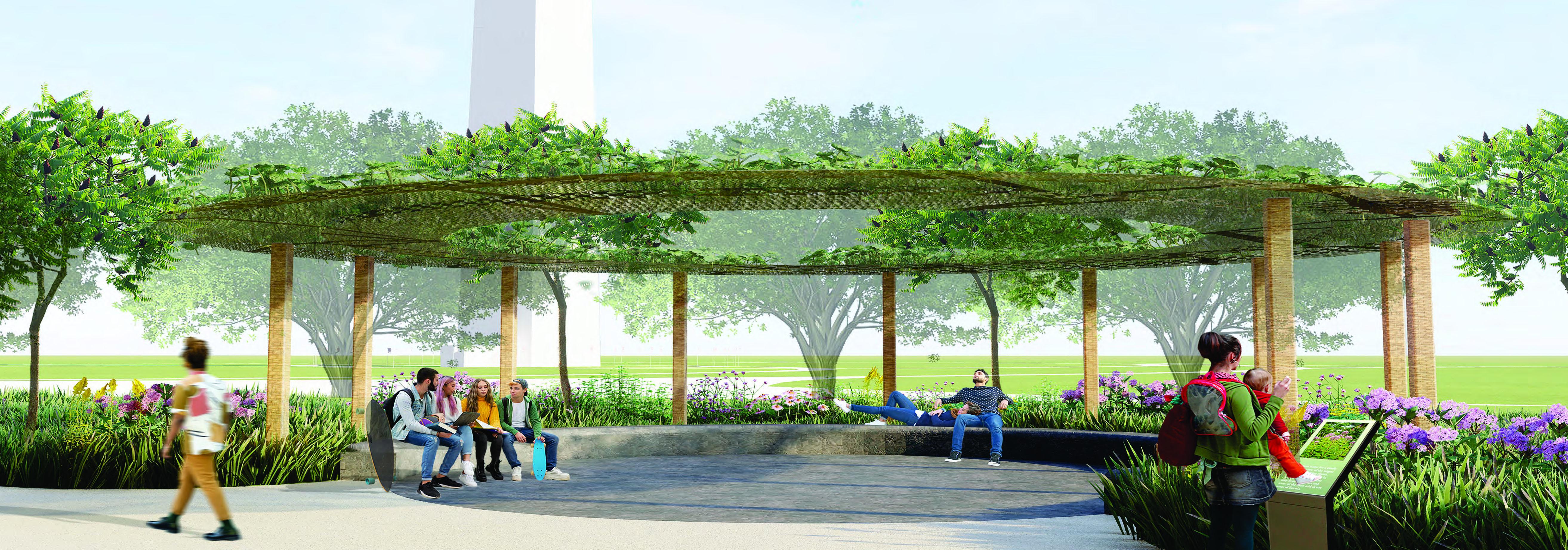UMD Landscape Architecture Students Re-envision the Grounds of the National Museum of African American History and Culture
Charlotte Yang presents her design to museum curators and staff on site at the museum in Washington, D.C.
Image Credit: Kimbra Cutlip
When the Smithsonian National Museum of African American History and Culture opened in 2016, it made a splash for its showy exterior architecture and evocative interior exhibits. More than nine years and ten million visitors later, the museum remains a popular destination where throngs gather daily and wait in long lines to gain entrance.
Recently, a group of students from the University of Maryland’s Landscape Architecture Program re-imagined that wait, designing an outdoor extension of the museum, where the landscape would echo elements of the stories told inside the building.
Professor Jack Sullivan’s Urban Design Studio class met with museum curators, toured the grounds and the exhibits, and then, after developing their own landscape designs, presented their ideas to museum leadership.
“It was a unique opportunity for them to experience a real-world design challenge in this beautiful location that also has real significance and meaning,” Sullivan said. “They had to think about what messages they wanted to convey and how to do that appropriately through design.”

The students had to consider which of the various stories and messages told inside the museum could be amplified outside while accounting for weather, adjacent vehicle traffic, and noise as well as how people move through the space and other considerations.
Student designs included features such as an overhead lattice that projects shadows in patterns evoking an African Kente cloth, and a walkway with signage and audio stories from prominent African Americans throughout history.
“This was such a fun project to work on,” said Abby Erwin, whose design incorporated a story tree and a gathering place that echoes African American traditions. “Having the rich history and background to work with was a great opportunity to think about working with a theme and bringing that context to the design process.”
Other designs also drew from cultural history such as Gabrielle Shelton’s, which included a gathering space and performance area shaded by an arbor to symbolize the wooded, protected spaces where enslaved people would go to secretly practice their faith.
Many students factored in the practicalities of the setting as well, like Kennedy Thomas-Cogar whose design included a water wall made of glass to dampen nearby street noise, and a sculptural exhibit space where different aspects of historic and modern African American art and culture could be displayed on a rotating basis.
Sullivan developed the idea for the project after meeting the museum’s Assistant Director of Council Operations and Museum Initiatives, Carla Thomas McGinnis. She was enrolled in his landscape and garden history seminar and was pursuing a PhD in American studies. The two got to talking about the synergy between his landscape architecture program and her interests in the relationship between African Americans and the landscape.

Thomas McGinnis said the museum staff had been considering ways to bring a more curated experience to the museum grounds. For example, they had already been incorporating plants with significance to African American heritage like fish peppers and sweetgrass into the gardens surrounding the museum. Sullivan saw an opportunity for his students to put their skills and creativity into practice, and Thomas McGinnis agreed it would be an exciting collaboration. She helped facilitate student visits to the museum and discussions with curators.
When the students presented their designs to museum staff, she was excited to see the variety of creative ideas that emerged. “I love how they're all thinking about it differently,” she said. “It's interesting to see how some choose to lean into the shapes and colors of the existing building, and some highlight views of the Washington Monument, and others are like, no, let's go in a different direction.
Thomas McGinnis was also impressed by the level of visitor engagement the students designed into the space. “The students are not just seeing visitors walk through the grounds to get inside the building,” she said, “but they are creating meaningful experiences visitors can have before or after they encounter what's inside.”